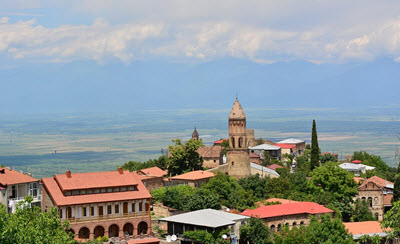Contents
 Georgia has five main regions of viniculture and Kakheti is generally hailed as the most important one for the country’s economy.
Georgia has five main regions of viniculture and Kakheti is generally hailed as the most important one for the country’s economy.
The basins Alanzani and Iori are renowned for producing high-quality Georgian wines. Here, the grapes grow on humus-carbonate, black and alluvial soils, in vineyards situated 400 – 700 meters above sea level.
Both traditional Georgian wine-making methods and methods imported from Europe are employed in Kakheti. Traditionalist wine-makers will press their grapes in a satsnakheli winepress and pour the winemust into a qvevri, a type of earthenware vessel where wine is fermented, stored and aged. The chacha (grape skins, stalsk and pips) is left in, but will sink to the bottom of the qvevri as the alcoholic fermentation is completed. The first racking typically takes place in March, after which the wine is aged for a year.
For many centuries, Kakheti has been hailed for its high extraction table wines, wines containing a lot of phenolic compounds and tannins.
Examples of grape varieties grown in Kakheti
| Budeshuri |
| Cabernet-Sauvignon |
| Kakhuri Mtsvane (known internationally as Kakhetian Green) |
| Khikhvi |
| Kunsi |
| Mtsvivana |
| Qisi |
| Rkatsiteli |
| Sapena |
| Saperavi |
| Tavkveri |
Of these, the most wide-spread grape variety in Kakheti is the Saperavi. In this region, Saperavi is used both for European-style wine and traditional Georgian-style wine, including some excellent pink and sparkling wines.
Examples of Kakheti wines
| Akhasheni |
| Gurjaani |
| Kakheti |
| Kardanakhi |
| Kindzmarauli |
| Kotekhi |
| Kvareli |
| Manavi |
| Mukuzani |
| Napareuli |
| Teliani |
| Tibaani |
| Tsinandali |
| Vazisubani |
About Kakheti
Modern-day Kakheti contains both the historical province of Kaktheti and the adjoining mountainous province of Tusheti. Located in the easternmost part of Georgia, Kakheti borders Chechnya and Dagestan to the northeast and Azerbaijan to the southeast. Both Chechnya and Dagestan are federal subjects of The Russian Federation.
| Area | 11,311 km2
(4,367 sq mi) |
| Population | 319,144 (2014 census) |
| Capital | Telavi |
Historically, Kakheti has been divided into four sub-regions:
- Shida Kakheti (Inner Kakheti)Located east of the Tsiv-Gombori mountain range, along the right bank of the River Alazani.
- Gare Kakheti (Outer Kakheti)Located along the middle Iori River basin.
- Kiziq’iLocated between Alazani and Iori
- Thither AreaLocated on the left bank of the Alazani
 Thou Art a Vineyard
Thou Art a Vineyard
The lyrics to the famous medieval Georgian hymn “Thou Art a Vineyard” was written in Kakheti. In Georgian, the title is შენ ხარ ვენახი, transliterated: Shen Khar Venakhi.
King Demtrius I of Georgia (1093-1156) wrote the lyrics during his confinement as a monk in the David Gareja Monastery in Kakheti. The hymn is dedicated to Georgia and the patronage of the Virgin Mary. It is usually sung a cappella by a choir and is a classic example of Georgian choral music.
By likening the Holy Virgin to a vineyard, the writer reveals the reverence that Medieval Georgians had for their vineyards and the tradition of making wine.
| Georgian text | Transliteration | English translation |
| შენ ხარ ვენახი, ახლად აყვავებული,
ნორჩი კეთილი, ედემს შინა ნერგული, (ალვა სუნელი, სამოთხეს ამოსული,) (ღმერთმან შეგამკო ვერვინა გჯობს ქებული,) და თავით თვისით მზე ხარ და გაბრწყინვებული. |
Shen khar venakhi, akhlad aq’vavebuli,
Norchi k’etili, edems shina nerguli, (Alva suneli, samotkhes amosuli,) (Ghmertman shegamk’o vervina gjobs kebuli,) Da tavit tvisit mze khar da gabrts’q’invebuli. |
You are a vineyard newly blossomed.
Young, beautiful, growing in Eden, (A fragrant poplar sapling in Paradise,) (May God adorn you. No one is more worthy of praise,) You yourself are the sun, shining brilliantly. |
Both a Kartli-Kakhetian version and a Gurian version of the music exist, and they are quite different from each other. The composer or composers remain unknown.
David Gareja Monastery
The David Gareja Monastery is a rock-hewn Georgian Orthodox monastery complex located in Kakheti, on the arid slopes of Mount Gareja. The monastery was founded by the Assyrian monk David Garejeli in the 6th century.
The complex includes churches, chapels, refectories, living quarters, and hundreds of cells – many hollowed out of the rock face. The complex is one of the oldest known human habitations in this specific area.
Today, the complex and its surrounding area is also important as a home for endangered animal species.